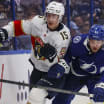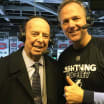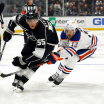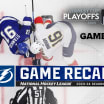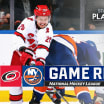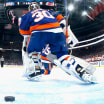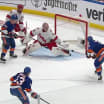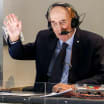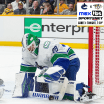It will be a new experience for the San Jose Sharks' Martin Jones and the St. Louis Blues' Brian Elliott when they are starting goalies in the Western Conference Final, with Game 1 at Scottrade Center on Sunday (8 p.m. ET; NBCSN, CBC, TVA Sports).
Jones is seeing his first action as a starting goaltender in the Stanley Cup Playoffs. Elliott is making the most of another chance to be the Blues' No. 1 goalie in the postseason.
Sharks' Jones has edge on Blues' Elliott
San Jose goalie better in positioning, post play
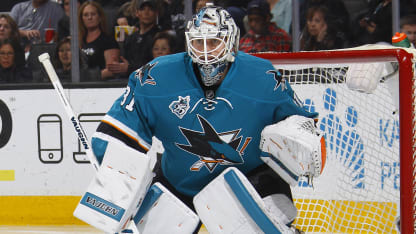
© Rocky W. Widner/NHL/Getty Images
By
Kevin Woodley
NHL.com Independent Correspondent
Each has gotten to this point with numbers that mirror his regular-season results.
Jones had a .918 save percentage in 65 games in the regular season, his first as a full-time NHL starter. He has matched that save percentage through 12 playoff games.
Elliott has a .929 save percentage through two seven-game series against the Chicago Blackhawks and Dallas Stars, close to his NHL-leading .930 save percentage in 42 regular-season games.
Their playoff success comes in part because they have stuck to what made them successful in the first place and haven't abandoned their individual tactics and technique under the pressure of the postseason. Their styles are different, however, with unique elements the other team will try to exploit, so let's take a closer look at how each goalie plays.
POSITIONING
Jones and Elliott are not aggressive. Jones has a style and positioning that match the calm demeanor teammates so often praise. He plays a patient, controlled game on his skates, wandering slightly past the top of his crease and retreating on rush chances but playing at three-quarters depth within the blue ice when play is in the San Jose end. He's been caught chasing a few plays wide of his crease in the playoffs, especially on chances moving to his blocker side. But for the most part he's stuck with his contained, positional approach, forcing shooters to beat him but rarely beating himself.
Elliott starts deeper in the net on end-zone play, getting his heels past the top of his crease against the rush but mostly playing inside his crease, prioritizing the early angle ahead of depth with short movements that make it easy to stay in the middle of the net and square to the shooter. He will take more ice when he reads an open shot, but it's an inside-out approach that starts back in the crease, which can leave him exposed high on shots from the slot. The Blues surrendered a lot of those in Games 1, 4 and 6 against the Blackhawks. This situation occurs when Elliott doesn't stay patient on his skates and reactive with his hands.
Advantage Jones:His positioning is more neutral and his extremes are easier to target.
BLOCK/REACT THRESHOLD
Elliott's positioning and size leave him little choice but to stay active with his hands. He holds his glove above his shoulder which helps take away the top corner shooters often default to with time and space, but it can make for tougher saves in the middle of the net, and the Blackhawks handcuffed him there with three clean-shot goals in the first round. When he starts to drop his hands early, Elliott can be exposed high, which was the case when four of the Stars' final six goals in the second round came on clean looks.
Jones is at his best when his patience on his skates is matched by his tracking into shots, which allows him to keep his hands active. When he starts pushing to the ice with his knees, straightening his upper body and pulling back with his hands on the shot release, it not only leaves him exposed high but also causes delays and coverage deficiencies in his recovery movements. It's more prevalent when he is moving to his blocker side. That area can be targeted for traffic because he prefers to look over screens, which can leave him a little exposed along the ice and under the pads, something that led to two goals against the Los Angeles Kings in the first round. Ten of the 17 goals the Nashville Predators scored in the second round involved rebounds, broken plays and screens.
Advantage Elliott:His deeper style means he relies so much on maintaining active hands.
PUCK-HANDLING
Neither goaltender handles the puck a lot, but Jones is effective when he does, making simple plays to alleviate pressure and start the transition. Elliott, who was given a delay of game penalty for clearing a puck over the glass against the Stars, rarely plays the puck. Blues coach Ken Hitchcock admits his defense plays differently when Jake Allen is in net because of his ability to handle the puck and start the transition, whereas Elliott freezes more plays to set up faceoffs in his end.
Advantage Jones: At least he handles the puck a little.
POST PLAY
Jones uses a variety of post-integration techniques depending on the type of attack and its proximity to the goal line. On plays above the goal line he uses a traditional VH, with the lead pad stacked vertically against the post and the back pad lying horizontal on the ice on plays above the goal line. When the puck is behind the net he prefers the reverse-VH, with the post pad on the ice and the back skate dug in to help him seal the post and steer his rotation around it. However, he won't linger in either too long, and while he got beat through the five-hole a few times by opening on wraps and walkouts during the season, it has cost him one goal in the playoffs, on a Ryan Johansen backhand in tight and under the pad against the Predators in Game 6.
Elliott seems to have a nice balance between staying on his skates and using reverse-VH as a save selection rather than deferring to it too early, but the Blackhawks caught him leaving the short-side post early on plays behind the net several times, leading to two goals in the series. And his skate-on-post execution of reverse-VH left a short-side gap that the Blackhawks also found a couple of times. He was beaten on six sharp-angle or low/high plays that started behind the net in the first round, and the Stars also caught him flat on the goal line with a couple of plays from behind the net in the second round.
Advantage Jones: He gets better rotation around his posts and uses several techniques.
SCORING TRENDS
Jones' conservative positioning leads to exposure around the perimeter of the net. Seven of the 17 goals scored by the Predators were into the high corners, but several required near-perfect shots just inside the posts. He's given up fewer goals through his coverage through two rounds than the Predators' Pekka Rinne gave up in Game 7 alone. Jones moves better to his left than to his right and tends to get caught moving flat across the crease to his blocker side, which has led him to chase plays past his right post.
The low/high pass-outs from behind the net were an issue for Elliott by the end of the first round, as was a tendency to shrink behind traffic. But the bigger concern late in the second round was that he was dropping his hands early, especially when the Blues gave up clean looks in the middle of the ice. Those aren't easy for any goalie, but Elliott has to stay patient and active with his hands to succeed, especially considering he has the lowest save percentage against opponents' power plays (.849) of the four starting goalies left in the playoffs, and the Sharks' power play is second in the League at 30.9 percent. Sharks forward Joe Pavelski, who works hard in the offseason to develop different and deceptive shot releases, will test that patience.
Advantage Jones: Elliott has been exposed on sharp angles and clean looks.


